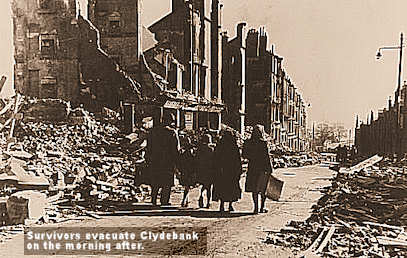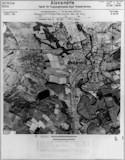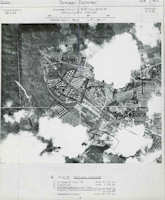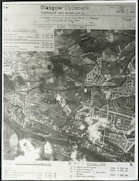WW2 Aerial Reconnaisance Photograph of RNTF
This Luftwaffe aerial reconnaissance photograph taken on 2nd October 1939, shows the Royal Naval Torpedo Factory (RNTF) in Alexandria. This was one of a series of photos taken of Clydeside in general on that flight by the high-flying reconnaissance plane which had set out from Germany.
the image of the Vale of Leven with the Royal Naval Torpedo Factory highlighted. (Click this image to enlarge.)
These photos were obviously going to be used by the Luftwaffe planners to develop targets on Clydeside as part of the air war against Great Britain. At the time there was a universal feeling amongst the military, politicians and the public at large that “the bomber would always get through” so they were potentially a very potent threat to Clydeside in general and the Vale. As we now know, the Luftwaffe delivered on that threat with deadly raids on
- Clydebank and Glasgow (13/14th March 1941 and 14/15 March 1941)
- Greenock (5/6 May 1941 and 6/7th May 1941)
- Dumbarton (March and May 1941)
- even Cardross was attacked in the Cardross Blitz of 5th May 1941
But the Vale was never attacked, although a few stray bombs fell at Ballaghan and Renton and the hills above Bonhill took a pounding as to a lesser extent did Carman. These two latter locations were the sight of substantial “Starfish” decoy installations which proved their worth as the Germans attacked them believing them to be fires in an already-burning Clydebank.
So the RNTF photo raises the question – why did the Vale escape being bombed since the Germans obviously knew all about the Torpedo Factory?
This is an image similar to that shown above. This one is of the western end of Clydebank and the Oil Fuel Depot at Dalnottar, which unfortunately did not get off as lightly as the vale (Click this image to enlarge.)
The answer to the main question though, why was the Vale not attacked? is probably simple enough – the Germans didn’t think that it was important enough to accord it a high priority in the early stages of the war. In the later stages they were far too preoccupied in Russia and trying to stem the incessant RAF night raids to give the RNTF another thought. Ironically enough the Torpedo Factory may have been of greatest risk of attack in the last months of the War, for reasons which we will explain.
It’s also worth noting that a much greater potential target, one even easier for them to identify by day or night than the RNTF and one which was more vital to the German war effort, lay just over the hill in the Gareloch. After the fall of France in the summer of 1940 the UK ports in the south of England were within very easy reach of Luftwaffe bombers based in very large numbers in France in particular.
A new, safer, large civil and military port was needed as far away from the bomber bases as was practical. The UK government designated the Clyde as a strategic location for a new wartime base which although it was not beyond the reach of German bombers – after Norway was captured nowhere in the UK was beyond the comfortable reach of German bombers – the Clyde was at least far enough away for the British fighter defences to act as something of a deterrent. From the autumn of 1940, therefore, the Gareloch was literally chock-a-block with British and American targets. Since America would not be in the war until December 1941, the US presence was legally and nominally a civilian one, but on 8th December 1941 the key Americans working on building the base at Rosneath and the pipeline from Finnart to Old Kilpatrick turned up for work in US Naval uniforms.
It is still very surprising that there was no German air raid on the Gareloch or that any German lone raider ever ventured near it. So if the Germans didn’t attack the Gareloch in their sorties against the Clyde in spring 1941 perhaps we shouldn’t be too surprised that they didn’t attack the RNTF. But it’s not quite as simple as that, because part of the German bomber force making for Clydebank and Glasgow flew directly overhead the Vale and the Torpedo Factory. Some of the waves of bombers coming from Norway had rendezvoused over Loch Lomond – it was chosen precisely because it was unmissable even at night, as was the River Leven flowing between it and the Clyde.
This is another image taken by the Germans during the same (2/10/1939) aerial reconnaisance mission as those above. This one is of a prime target, John Brown's Shipyard, which they effectively missed. (Click to Enlarge)
This link displays a very interesting map of the bombing pattern on Clydebank and Old Kilpatrick.
As the bombers turned south towards Clydeside some flew down the Vale. It would have been a simple matter to allocate a few of them to drop their bombs in the Vale. No accuracy would have been required to carpet the Vale and take out the Torpedo Factory but fortunately they didn’t do that otherwise many of us might not be around. Most probably, to the Luftwaffe planners the choice of targets on Clydeside ranging from oil tanks to shipyards, ships and engineering works, seemed too good to miss.
In the event the bombers did their greatest damage not in attacking any of these but in virtually destroying the whole housing stock in Clydebank, killing more than 500 people in the process as well hitting civilian targets in Glasgow and killing another 800 people in the city.
Maybe they intended to come back on subsequent attacks but events overtook them. After the raids on the Clyde in the spring of 1941 there were no more major raids on the west of Scotland. By the summer of 1941 the major part of the Luftwaffe bomber force was committed in Russia, and even London and the south of England saw a noticeable drop-off in the number of night attacks, while large-scale day-time attacks had been stopped by the RAF’s victory in the Battle of Britain.
 That is not to say that there were no more air raids in Scotland; far from it. As Les Taylor has shown in his very informative book “Luftwaffe over Scotland” (2010) German air activity around Scotland started in the first days of the war and lasted right until the 21st April 1945, just two weeks before the end of the war. On that day 18 aircraft from the Luftwaffe base at Stavanger in Norway took off to attack shipping in the north-east of Scotland. It was not only pointless, it was suicidal because of the 18 aircraft only 4 made it back to Norway, the rest having been destroyed by 42 Mosquitoes from Banff Strike Wing.
That is not to say that there were no more air raids in Scotland; far from it. As Les Taylor has shown in his very informative book “Luftwaffe over Scotland” (2010) German air activity around Scotland started in the first days of the war and lasted right until the 21st April 1945, just two weeks before the end of the war. On that day 18 aircraft from the Luftwaffe base at Stavanger in Norway took off to attack shipping in the north-east of Scotland. It was not only pointless, it was suicidal because of the 18 aircraft only 4 made it back to Norway, the rest having been destroyed by 42 Mosquitoes from Banff Strike Wing.
This was the last Luftwaffe attempted attack on the UK, the Luftwaffe having long since lost the capability to raid southern England. However it does illustrate the one threat to the security of the UK by the spring of 1945 – the virtually intact Luftwaffe forces in Norway.
 Apart from terrorising the vast majority of the Norwegian population opposed to the occupation, the Germany Army in Norway sat out the war, safe from any actual fighting. The navy and air force had been active against the Russian convoys which sailed from North-West Scotland to Archangel.
Apart from terrorising the vast majority of the Norwegian population opposed to the occupation, the Germany Army in Norway sat out the war, safe from any actual fighting. The navy and air force had been active against the Russian convoys which sailed from North-West Scotland to Archangel.
The Luftwaffe was also very active against the north-east of Scotland with a regular series of small-scale attacks and lone raiders against places such as Wick, Peterhead and Fraserburgh where a large machine tool factory offered an attractive target to them. RAF counter measures were very effective but small groups coming in at low levels sometimes got through.
The UK air defence commanders had to take account of these raids, no matter how minor they were in the general scheme of things. The Anti-Aircraft defences of the Clyde Basin were the responsibility of the 12th Anti-Aircraft Division which was headquartered in Pollockshields in Glasgow. One of the components of the 12th Division was the Searchlight Sites command and its HQ for most of WW2 was Auchendennan House. In total 12th Division had 45 Heavy AA Batteries across its area, each consisting of 4 guns – usually 3.7 inches caliber which were radar controlled.

The Luftwaffe would have come from this direction, over Loch Lomond towards the Vale from their Norwegian base. The Torpedo factory, prominent in the centre right, would have made an easy target had they decided to bomb it. One can only speculate on the number of casualties there would have been in the immediate surrounds, which include the tenements of Argyll Street and Govan Drive.
To begin with these Batteries were manned by regulars but eventually the Home Guard took over manning them, freeing up the regulars for other duties, often in the fighting overseas. In 1943 Anti-Aircraft Defence in the West of Scotland was exclusively the responsibility of the Home Guard. They manned the various Heavy and Light AA Batteries which constituted the Clyde AA defences during daylight hours and at other times as required.
The Vale was within these defences and there was an Heavy AA Battery on the Horse-Shoe close to Lochend Farm as well as a searchlight in the vicinity of Ashfield Farm which might just have been the target of a German land mine which came down in what used to be “The Whins” about 150 yards north-west of Ashfield during the Clydebank Blitz.
There were many other searchlights and Heavy AA Batteries at places such Geilston and Mollandhu in Cardross, Upper Helensburgh on the Black Hill and Gooseholm at Dumbarton. As has been mentioned there were also the two Starfish Decoy systems in the hills above the Vale, one called Kipperoch at Renton and the other above what is now Beechwood Estate, Bonhill. Needless to say none of these defences were intended to protect the Vale specifically.
Armaments and aircraft factories received their own light AA defences, although to begin with these defences were extremely light. The late Brian Osborne in his book “The People’s Army, the Home Guard in Scotland 1940-1944” (2008) records that in early 1943 the Home Guard defended the Torpedo Factory against air raids with 12 light machine guns. He further writes that by 1944 “when one might have thought that the risks were diminished, many of the west of Scotland sites would have their defences increased.”
The Home Guard at the Torpedo Factory replaced their 12 light machine guns with 6 20 millimetre cannon. These cannon would have been quite a formidable weapon against any low-flying single raider or small group of planes. It is quite possible that the AA Command had the Luftwaffe raiders out of Norway in mind when they carried out this upgrade to the Torpedo Factory’s defences in 1944. As we’ve already said they were a regular nuisance in northern Scotland right up until the end of the war and it was a wise precaution to upgrade defences elsewhere. In the event, neither the RNTF nor the Vale was ever attacked by the Luftwaffe, thankfully.
Postscript: Graham Lappin has provided a fascinating insight into the local Home Guard (Dad's Army) activities in this area during WW2. This is available here (complete with hand drawn maps) as a downloadable document.





